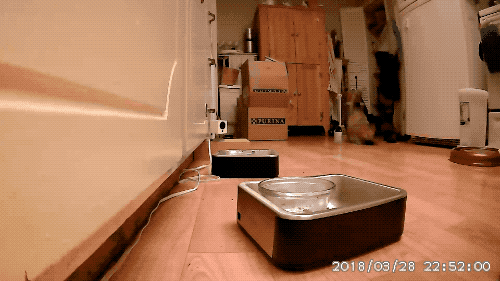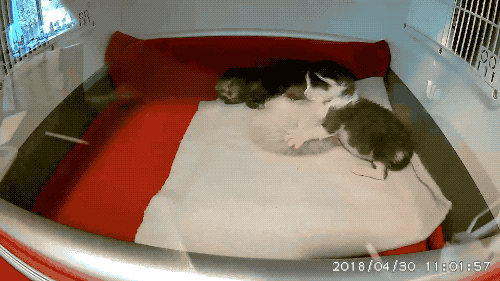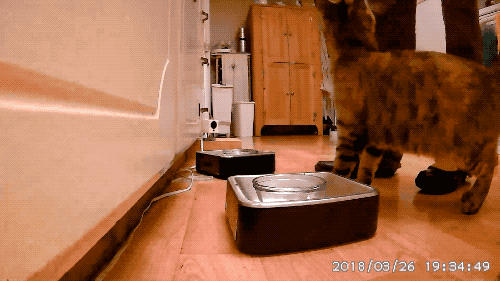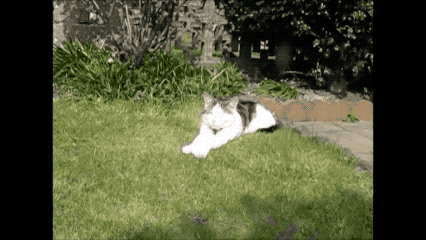Now Playing: The (Real) Secret Life Of Pets
16:32 minutes
If you want the real scoop on what your cat is doing while you’re away, researchers are studying that very question, using cat cameras. Our feline friends spend quite a lot of time outside of our line of sight, and we imagine them napping, bathing, playing, hunting. But that’s merely speculation. To get the data, researchers need to catch them in the act. Maren Huck, Senior Lecturer at the University of Derby in the UK, recently published a methodological study where she successfully tracked the movements of 16 outdoor domestic cats to find out what they were up to. She joins Ira to discuss the findings, which she published in the journal Applied Animal Behavior Science.
Plus, cat behavior specialist and University California, Davis veterinary school researcher Mikel Delgado joins the conversation to talk more about catching cat behavior on camera, and what we can learn from recording their secret lives.




Maren Huck is a senior lecturer at the University of Derby in Derby, United Kingdom.
Mikel Delgado is a postdoctoral researcher at the School of Veterinary Medicine at the University California, Davis in Davis, California.
IRA FLATOW: This is Science Friday. I’m Ira Flatow. When it debuted in 2016, The Secret Life of Pets ranked number one opening weekend, and it raked in over $100 million bucks. Not a bad haul for an animated movie about the adventures of apartment-dwelling cats and dogs– and one rabbit named Snowball. What makes that movie so appealing, even worthy of a sequel, is there’s one question that I’m sure every pet owner has. What are my pets doing when I’m not at home? To see, well, researchers are starting to figure out how to answer that question for cats.
Our feline friends spend quite a lot of time outside of our line of sight, either napping, or bathing, or playing, or hunting. But that’s merely speculation, because, well, we don’t know what they’re doing. So to get the data researchers need to catch them in the act on camera, they need cat cams. And that’s what they did. My next guest recently published a methodological study where she successfully tracked the movements of 16 outdoor domestic cats to find out what they were up to. She joins me now via Skype from the UK. Maren Huck is a senior lecturer at the University of Derby. Dr. Huck, welcome to Science Friday.
MAREN HUCK: Good evening, afternoon probably,
IRA FLATOW: Yes, it is. Thank you. You were the first person to do something like this on this scale, 16 cat cameras. What made you want to try something like this?
MAREN HUCK: I’m by no means the first one who did this, so there have been other people who have used cat cameras on cats and probably even more cuts. They had a slightly different approach to it. So they used that to answer a specific questions like how much are they hunting and things like that? Or how often do they cross dangerous roads from the animal welfare perspective? And I have done this coming from a similar direction, because I wanted to know how much they hunt as well. But when I watched the videos, I thought actually we can get much more out of it. And we can actually see what kind of behaviors they are doing. And I was intrigued to use that because often it’s very difficult to find out what animals are doing when they are out of sight, obviously. And it is very likely that animals behave differently when no are observers there.
IRA FLATOW: Why are people so interested in this, to know what their cats are doing?
MAREN HUCK: Well, there are various angles to this. So there’s obviously the angle to the whole predation problem of cats, so that you want to know what they are hunting, how much they’re hunting, where there are certain types of habitats where they are hunting more so that you can try to regulate the hunting more. And also to try to find out whether there are certain things that can be done to reduce it. There’s also the cat behavior study perspective of the cat welfare perspective. So we can learn much more about the behavior of the cats and, well, quite a lot of people like cats very much, they are great companions, so we want to understand the animals that we are living with and what they are up to.
IRA FLATOW: Yeah. Can you give us some results of what you saw the cats doing? What were they doing?
MAREN HUCK: Well, cats are obviously very I would say patient animals. So what you can see them doing a lot is sitting around but being alert. So you can see from the cat camera footage that they’re sitting for half an hour or more at the same spot. But you can see from the slight movement in the video camera that they’re constantly scanning their surroundings, seeing what’s going on. But interspersed with that there is also quite a lot of exploration, for example. So a little bit of sniffing here, a little bit of sniffing there. There might be the odd encounter with neighbor cats, and that again I found very interesting, the way they interact and no other humans around. So that was quite interesting for me.
IRA FLATOW: I’d like to bring in another cat researcher who is using cat cameras in her work. Mikel Delgado, postdoctoral researcher at the School of Veterinary Medicine at UC Davis. Dr. Delgado, welcome to Science Friday.
MIKEL DELGADO: Thank you, Ira.
IRA FLATOW: What intrigued you about Dr. Huck’s study when you saw it? Did Dr. Huck come up with anything that you found unusual?
MIKEL DELGADO: I loved that the study really focused on methodology, because so many times we see the results of a study and we don’t ask, how did the scientists collect the data? And so this study was really important because not only did Dr. Huck look at what was showing on the cat cams, but they validated that data by also doing a second camera on the cat where they could see what the cat’s perspective was compared with what they actually observed the cat doing. So that really helps those of us that do study cats understand what are the best methods and what can we discern from a cat cam? What can’t we discern from a cat cam?
So I don’t want to speak for Dr. Huck, but I know some behaviors were easier to track from the cat cam than others– behaviors like scratching and climbing versus perhaps it’s more difficult to discriminate between resting or sleeping. And so that really can help future researchers refine their methods in studying cats using cat cams and knowing what they can use them for and what they might need to use other methods for.
IRA FLATOW: We’ve all heard the old expression about how difficult that is to bell a cat. How difficult is it is it to place a camera on a cat who will actually cooperate with you, Dr. Huck?
MAREN HUCK: I think there are two types of cats, really. There are the cats that perhaps often a little bit of being slightly disgruntled also will tolerate the collar quite, well, I would say cheerfully, not quite but they don’t mind it too much. And then there are cats where you immediately see they don’t accept the collar and then we obviously wouldn’t continue trying it. So if the cat says no, then that is a clear no for welfare reasons. But the cats that I tried it on, and those for which we had the data didn’t show any signs of distress essentially.
IRA FLATOW: Dr. Delgado, how successful have you been in putting cameras on cats?
MIKEL DELGADO: We’re not putting cameras on cats. We are actually studying indoor cats, and we have a separate cameras monitoring the cats. We did use accelerometers, a little fitness or activity tracker, on the cats. Those were quite a bit lighter than your average cat cam, and so overall the cats did tolerate them, although we had a few cats in the study that didn’t even want to wear the small activity tracker. But we kind of skirted the cat cam problem by having external cameras viewing the cats instead of putting the camera on the cat. Again, because we were primarily interested in indoor cat activity rather than cats that have access to the outdoors.
IRA FLATOW: Dr. Huck, did you think about putting cameras scattered outdoors for your cats?
MAREN HUCK: I think that wouldn’t be feasible because the range size of the cats is too large and you would only see them for a short second. So you couldn’t really do the same kind of studies. You can use wildlife cameras for other purposes outdoors just to track, for example, how many cats are in an area. So that has been done for wild animals, wild felix as well. But you couldn’t really study the behavior in that sense. So you can do that for indoor animals, or for animals in a zoo or something like that, but to study that behavior in detail, you need something that you really observe the animals.
IRA FLATOW: Did you notice, and let me ask you first, Dr. Huck, did you notice any different behavior in the cats when they were around people and when they were not around people in stuff that they would be doing the same way?
MAREN HUCK: I think our data that we have collected so far is not enough to scientifically say something for definite, but from what I’ve seen, I would definitely say yes. And also from my own experience with my own cat, for which I have the largest proportion of the footage, when she was on her own outside she would essentially not use my own garden. She would go much further away, actually. But when I was around, I noticed that she was always within one or two meters. So she wouldn’t even leave the garden. She was very close to me, and not go away. So that was something that was definitely different when I was there.
Another thing, again which is very preliminary, which I think would be extremely interesting to study, is that I had the feeling that the vocalizations started to change, so that when the cat was outdoors, and I also think I noticed it in other cats, was when they were outdoors that the vocalizations of the cats sounded slightly different than when they were indoors.
IRA FLATOW: Mm-hmm. Interesting. Dr. Delgado, did you observe anything different?
MIKEL DELGADO: Well, we know that cats when– So our study was looking primarily at feeding behavior, and we know at feeding time that a lot of cats will solicit attention from their owners, either in the form of rubbing against them or meowing, circling, pacing. And so we do see a lot of activity at feeding time with the owner. And there are other things we know about cats.
For example, meowing is a behavior that is very much directed toward humans in adult cats. We know that kittens meow at their moms, but adult cats do not typically meow at each other. They use other types of vocalizations. And so we know that through the process of domestication, and living with humans and learning about humans, that cats have figured out that meowing is a successful strategy for getting food, for going outside, getting attention, all of those things.
IRA FLATOW: Interesting. Our number, 844-724-8455. Speaking of cats, let’s go to Jeff in the greater Houston area. Hi, Jeff.
JEFF: Hey, how are you guys doing?
IRA FLATOW: Hi, go ahead.
JEFF: I just want to make a comment. I love Science Friday, by the way, you guys are great.
IRA FLATOW: Thank you.
JEFF: But I read about cat cams years ago, and it spiked a little bit of curiosity on my part. So I got a cat cam for my cat, and then also I cannot remember the name of the message board, but I found out that there are a bunch of other people that had cat cams for their cats, too. And a little bit of behavior that I never expected to find out is that cats have multiple homes when they’re indoor/outdoor cats.
IRA FLATOW: What do you mean by that?
JEFF: Well, what I mean is, for instance, there was a kid down the street that I guess my cat was also his cat. And he would get off the school bus at say 3:15, come home and feed the cat, and my cat was at his house, and it was his cat. And my cat would go over there and get fed and hang out and get petted and purr and do all that stuff. And then I would get home from work at 6:00, and then suddenly my cat’s back in my house being my cat again and getting fed a second time.
IRA FLATOW: And you learn this from the cat cam you put on your cat.
JEFF: Yeah. Yeah, turns out my cat was cheating on me.
IRA FLATOW: Two-timing you. This is Science Friday from WNYC Studios. I think, Jeff, that’s a first for Science Friday we’ve heard of the cat cheating on its owner. Did the other owner know that it was cheating on it also? Did you go over there and talk to the other person down the block?
JEFF: No. I guess it’s a little bit of cat voyeurism. I just watched it. But yeah, no, the cat had two different families. And you know when I was out of town, it was their cat, and when I was in town it was my cat.
IRA FLATOW: That’s great living.
JEFF: And it had you had two different names.
IRA FLATOW: Two different names, two different lives. Thank you. Let me get a reaction from Dr. Huck. You your cats were roaming around. Did you notice anything like that?
MAREN HUCK: My current cat, I think, does visit the neighbors. But I still think that he thinks that he’s my cat. But my previous cat was very, very close to me, so I think she didn’t have a second home in that sense. But I’ve heard that before. So several cats do that. Yes.
IRA FLATOW: Do you think that people should be getting a commercial cat cams now and putting them on their cats to learn more about what they’re doing?
MAREN HUCK: I think it can be quite interesting for the owners as well, although I guess that, I don’t know how mad you need to be to watch hours and hours and hours of the footage. But I had some of my students use cat cams as well for some projects that they did and they gave it to friends and relatives. And my students told me that some of their friends were actually quite surprised, for example, at how social, in fact, the cats are in terms of their relation to their humans. That they were, for example, following their humans much more than the owners had actually realized. So they definitely learned something by watching the cat cam footage.
IRA FLATOW: What do you think, doctor, the dog owners are going to say about this? Are they going to say, hey, I need a dog ca, study, too?
MAREN HUCK: I guess when you’re going for a walk with your dog and the dog is free running then they might also learn things that they didn’t know. But I guess dogs are usually, definitely in Europe or in the UK, and I guess in the US as well, dogs are normally much more under control than cats are. So I guess there’s less time where a dog is away from their human. But it might be interesting to see what they are doing when they are in the house and the owner is away, so it might be still interesting.
IRA FLATOW: Dr. Delgado, would you agree with that in the house, dogs?
MIKEL DELGADO: Yeah, I mean dogs are with their humans much more than cats are. And so I think part of what drives the desire and the mystery, you know, what is my cat doing, is the fact that cats do spend much more time unsupervised. And as a society in general, we’ve accepted that cats are allowed to roam freely. There aren’t the same kinds of laws about free-roaming cats, and so I think that that adds to this desire to know what are they doing. And of course sometimes you find out, and maybe you’re a little bit shocked by what the camera reveals.
IRA FLATOW: Well, now that you know this, what do you do with this information you’re gathering, Dr. Delgado?
MIKEL DELGADO: Oh, what do we as cat owners or scientists?
IRA FLATOW: As scientists, what do you do now with this information?
MIKEL DELGADO: Yeah, I mean, I think that every time we are studying cats we usually have a specific hypothesis in mind, or a question that we want to answer. And sometimes we learn other things about how cats spend their time. And as Dr. Huck said, sometimes it’s a welfare-related question. And certainly for me, as someone who primarily studies cats who are housed indoors, I am concerned about their levels of activity. We know obesity is one of the most serious health problems facing our pets, and if they are sitting inside all day just sleeping, then that’s important information for us to know in regards to, OK, we need to provide enrichment and activities for our pets that can help them be more active, whether it’s when we’re gone or when we’re with them.
IRA FLATOW: I want to thank you both for taking time to be with us today, Dr. Maren Huck, a senior lecturer at the University of Derby, and Dr. Mikel Delgado, postdoctoral researcher, School of Veterinary Medicine at the University of California in Davis. Good luck with your cats.
MAREN HUCK: Thank you so much.
IRA FLATOW: You’re welcome.
Copyright © 2019 Science Friday Initiative. All rights reserved. Science Friday transcripts are produced on a tight deadline by 3Play Media. Fidelity to the original aired/published audio or video file might vary, and text might be updated or amended in the future. For the authoritative record of Science Friday’s programming, please visit the original aired/published recording. For terms of use and more information, visit our policies pages at http://www.sciencefriday.com/about/policies/
Katie Feather is a former SciFri producer and the proud mother of two cats, Charleigh and Sadie.
Ira Flatow is the founder and host of Science Friday. His green thumb has revived many an office plant at death’s door.